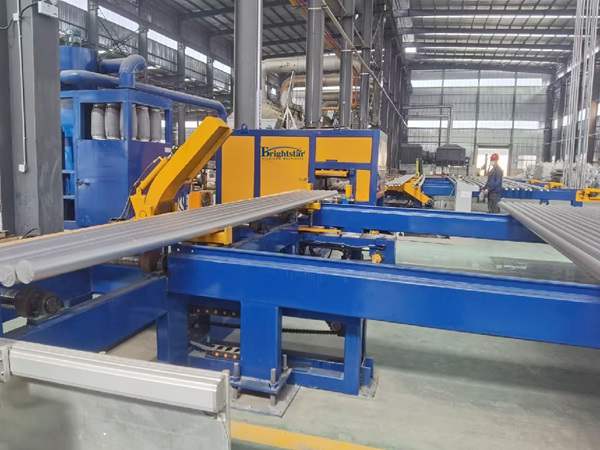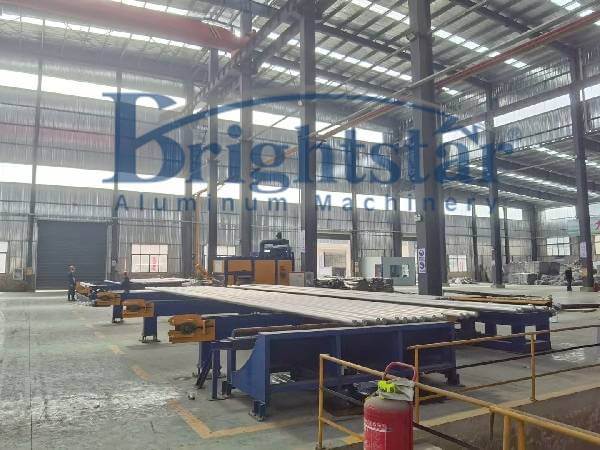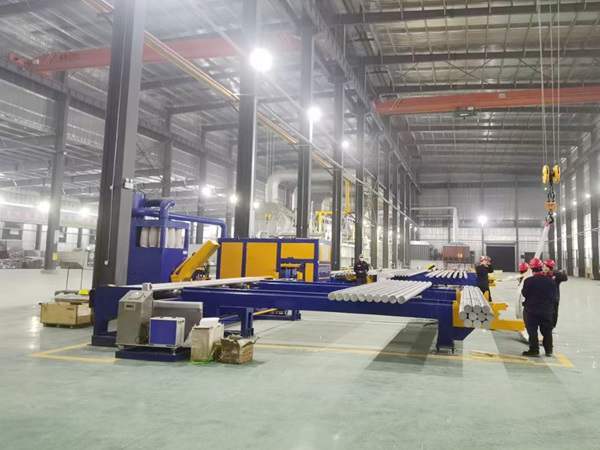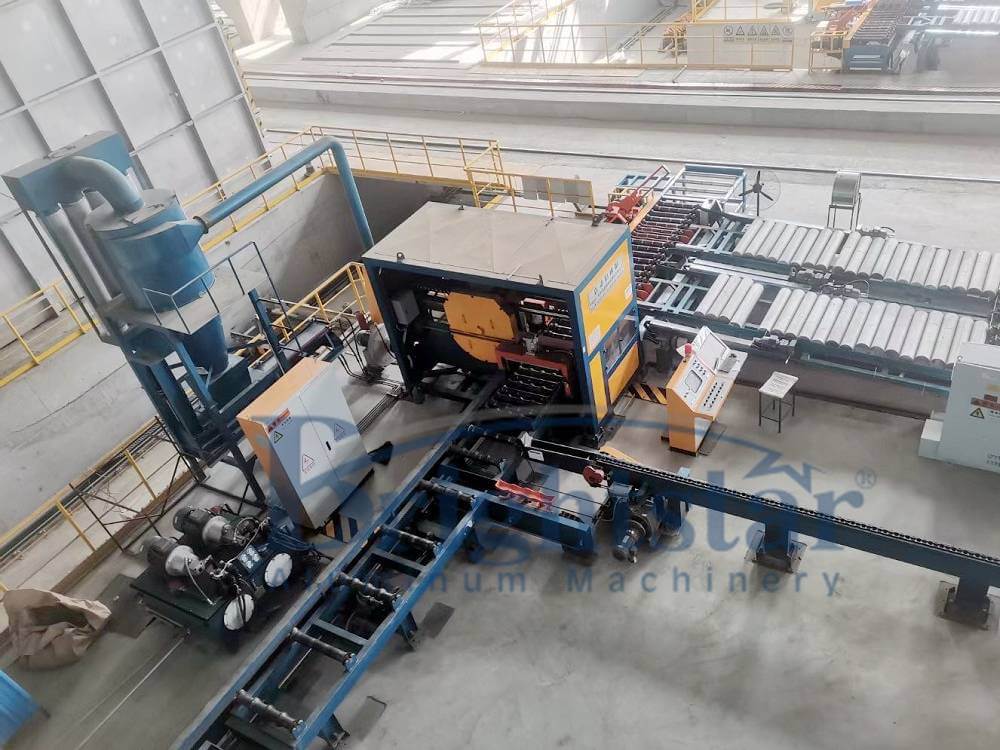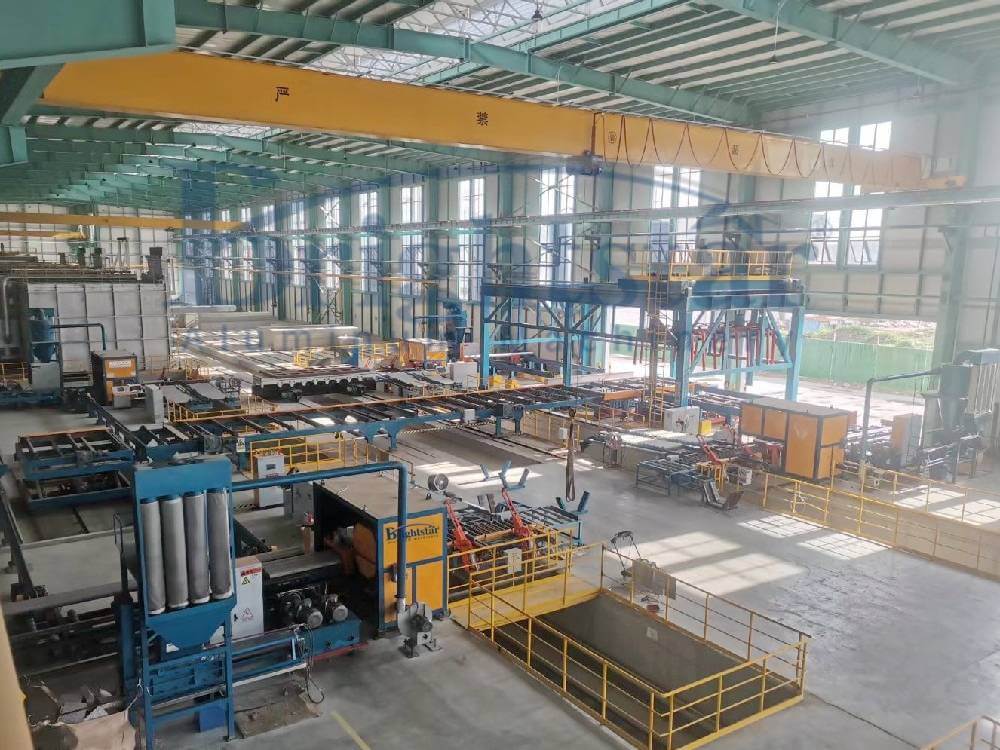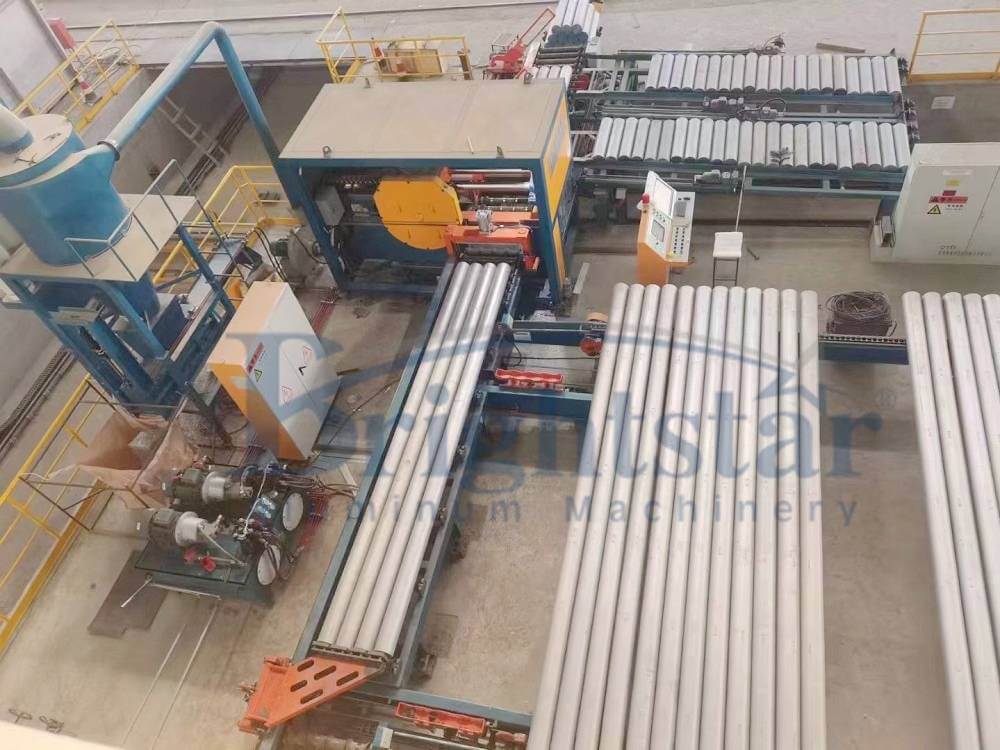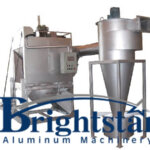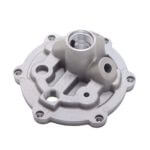All you need to know about aluminum billet cutting saw
All you need to know about aluminum billet cutting saw
What is an aluminum billet cutting saw?
An aluminum billet cutting saw is a machine designed for cutting aluminum billets into specific lengths or shapes.
These saws can be used for various purposes, such as cutting logs into long billets, short billets, or slices for further processing.
The machines are available in automatic or semi-automatic operation and are equipped with features such as automatic feeding, saw blade sawing, material delivery, and aluminum chip recovery.
The saws are designed to provide efficient and precise cutting of aluminum billets, ranging in diameter from 3″ to 12″ and in lengths starting from 3″.
What is the main part of aluminum billet cutting saw and the function of each part?
The main parts of an aluminum billet cutting saw vary slightly depending on the specific model and type (single-billet or multi-billet), but typically include the following:
1. Cutting Head:
Blade(s): The heart of the saw, made of high-quality carbide or diamond teeth for efficient and precise cutting of aluminum billets. Multi-billet saws have multiple blades arranged in a gang fashion.
Blade guide rollers: Provide support and stability for the blade during cutting, ensuring smooth operation and minimizing blade deflection.
Blade guard: A safety feature protecting operators from accidental contact with the spinning blade.
Feed rollers: Grip and push the billet through the cutting zone at a controlled speed for accurate and efficient cutting.
Spray system: For some models, a spray system directs coolant or lubricant onto the cutting area to reduce friction, heat buildup, and blade wear.
2. Billet Loading and Clamping System:
Conveyor or roller table: Guides and transports the aluminum extrusion or ingot towards the cutting zone.
Load plate or cradle: Positions and aligns the billet before clamping.
Clamping mechanisms: Securely hold the billet in place during cutting to prevent movement and ensure accurate cuts.
3. Control System:
Control panel: Allows operators to adjust cutting parameters like blade speed, feed rate, and cutting length.
PLC (Programmable Logic Controller): Controls the automated functions of the saw, including blade movement, feed rollers, and safety features.
Sensors: Monitor various aspects of the sawing process, such as blade positioning, feed rate, and coolant levels, for optimal performance and safety.
4. Support Frame and Base:
Robust frame: Provides a stable and rigid foundation for the cutting head and other components.
Base: Supports the entire saw and allows for secure mounting or portability, depending on the model.
5. Dust and Chip Collection System:
Chips recovery and briquetting: collect aluminum chips in the cutting and briquet aluminum chips for the transportation or melting
Extractor hood: Captures dust and chips generated during cutting for improved air quality and cleanliness.
Ducts and hoses: Transfer dust and chips to a collection bin or filtration system.
Additional components:
Emergency stop buttons: Located strategically for immediate shutdown in case of accidents or malfunctions.
Safety interlocks: Prevent the saw from operating if crucial safety protocols are not met.
Lubrication system: Maintains optimal lubrication of moving parts for smooth operation and extended lifespan.
Each part within the aluminum billet cutting saw plays a critical role in ensuring efficient, accurate, and safe cutting of aluminum billets.
Understanding the function of each component can help operators better utilize the saw, perform proper maintenance, and identify potential issues.
What are the benefits of using an aluminum billet cutting saw?
The benefits of using an aluminum billet cutting saw compared to other cutting methods are numerous and can significantly impact your aluminum processing operation.
Here’s a breakdown of some key advantages:
Enhanced Efficiency and Productivity:
Faster cutting speeds: Billet saws are specifically designed for aluminum and utilize powerful blades to achieve rapid cutting cycles, minimizing production downtime.
Reduced waste: Precise cuts and minimal burr formation compared to manual or less-controlled methods lead to less material waste and higher material utilization.
Automated operation: Modern saws offer automated loading, positioning, and cutting processes, minimizing manual labor and maximizing production throughput.
Improved Cut Quality and Consistency:
Accurate cuts: Advanced control systems and blade technology ensure precise cuts with minimal deviation from desired dimensions, crucial for downstream processes.
Smooth surfaces: Optimized feeding rates and blade characteristics minimize burrs and surface imperfections on the cut billets, leading to better product quality.
Reduced rework: Consistent and accurate cuts minimize the need for rework or corrections, lowering production costs and improving output.
Enhanced Safety and Ergonomics:
Reduced risk of operator injuries: Automation eliminates the need for manual handling and close proximity to the cutting zone, significantly reducing accident risks.
Improved work environment: Less dust and noise compared to manual cutting methods creates a safer and more pleasant work environment for operators.
Ergonomic benefits: Automation reduces physically demanding tasks and improves operator comfort, preventing fatigue and strain.
Additional benefits:
Versatility: Different types of saws cater to various billet sizes, shapes, and production needs.
Scalability: You can choose saws with appropriate capacities to match your production volume requirements.
Durability and reliability: Billet saws are built for heavy-duty applications and offer long service life with proper maintenance.
In conclusion, aluminum billet cutting saws offer a plethora of benefits over alternative methods, particularly in terms of efficiency, quality, safety, and ergonomics.
While their initial cost might be higher compared to some manual tools, the long-term gains in productivity, material utilization, and improved work environment often outweigh the initial investment.
Whether you’re a large-scale manufacturer or a smaller workshop, implementing an aluminum billet cutting saw can significantly enhance your aluminum processing operations and contribute to a safer and more efficient workflow.
What are the common applications of aluminum billet cutting saw?
Aluminum billet cutting saws find application in various stages of the aluminum production and processing chain, depending on the specific type of saw and production needs.
Here are some common applications:
1. Production of Billets for Further Processing:
Extrusion Billets: Cut long aluminum extrusions into shorter billets of specific lengths for subsequent extrusion into various shapes like tubes, profiles, and architectural components.
Forging Billets: Preparing aluminum billets with precise dimensions for forging processes, used in manufacturing automotive parts, aircraft components, and other high-strength applications.
Rolling Billets: Cutting ingots or extrusions into billets for processing in rolling mills to produce aluminum sheets, strips, and plates used in construction, packaging, and various industrial applications.
2. Specific Product Manufacturing:
Window and Door Profiles: Cut extrusions into precise lengths for manufacturing aluminum window and door frames, ensuring consistent dimensions and high-quality finished products.
Furniture Components: Preparing aluminum billets of specific sizes and shapes for use in furniture production, like chair legs, table frames, and decorative elements.
Building and Construction: Cut aluminum extrusions and ingots into billets for various architectural applications, such as building facades, cladding panels, and structural supports.
Prototyping and Design: Creating custom-sized aluminum billets for testing and prototyping new product designs or manufacturing one-off components with specific dimensions.
Specialty Applications: Preparing billets for niche applications like aerospace components, sporting equipment, or unique architectural elements requiring precise sizes and shapes.
3. Billet Sorting and Handling:
Pre-Sorting Billets: Cutting extrusions into shorter pieces before sorting them by size, grade, or other criteria for efficient inventory management and downstream processing.
Facilitating Handling: Cutting longer extrusions into smaller billets can make them easier to move, store, and transport within the production facility.
The specific applications of aluminum billet cutting saws depend on the saw type (single-billets vs. multi-billets), production volume, and final product requirements.
However, regardless of the exact application, these saws play a crucial role in ensuring efficient, accurate, and safe cutting of aluminum billets, contributing to various stages of the aluminum industry.
What are the advantages of using an aluminum billet cutting saw over other types of saws?
The advantages of using an aluminum billet cutting saw over other types of saws, like band saws, circular saws, or even manual cutting methods, are numerous and can significantly impact your aluminum processing operation.
Here’s a breakdown of some key advantages:
Enhanced Efficiency and Productivity:
Faster cutting speeds: Billet saws are specifically designed for aluminum and utilize powerful blades and optimized feed rates to achieve rapid cutting cycles, minimizing production downtime.
Reduced waste: Precise cuts and minimal burr formation compared to manual or less-controlled methods lead to less material waste and higher material utilization.
Automated operation: Modern saws offer automated loading, positioning, and cutting processes, minimizing manual labor and maximizing production throughput.
Improved Cut Quality and Consistency:
Accurate cuts: Advanced control systems and blade technology ensure precise cuts with minimal deviation from desired dimensions, crucial for downstream processes like extrusion or forging.
Smooth surfaces: Optimized feeding rates and blade characteristics minimize burrs and surface imperfections on the cut billets, leading to better product quality and reduced need for rework.
Consistent results: Automated processes and precise blade control ensure consistent cut quality across multiple billets, minimizing scrap and rework.
Enhanced Safety and Ergonomics:
Reduced risk of operator injuries: Automation eliminates the need for manual handling and close proximity to the cutting zone, significantly reducing accident risks.
Improved work environment: Less dust and noise compared to manual cutting methods creates a safer and more pleasant work environment for operators.
Ergonomic benefits: Automation reduces physically demanding tasks and improves operator comfort, preventing fatigue and strain.
Additional benefits:
Versatility: Different types of saws cater to various billet sizes, shapes, and production needs. You can find saws for single billets, multiple billets, and even custom configurations.
Scalability: You can choose saws with appropriate capacities to match your production volume requirements.
Durability and reliability: Billet saws are built for heavy-duty applications and offer long service life with proper maintenance.
Considering other types of saws:
Band saws: While offering flexibility and good cutting results, they might be slower and less efficient for high-volume production, and require more operator skill.
Circular saws: They offer portability and can be used for occasional cutting, but often lack the precision and cutting speed of dedicated billet saws for high-demand applications.
Manual cutting: While the cheapest option, it’s the least efficient, least safe, and least accurate, leading to higher waste and potential injuries.
Overall, aluminum billet cutting saws offer a multitude of benefits over alternative methods, particularly in terms of efficiency, quality, safety, and ergonomics.
While their initial cost might be higher compared to some manual tools, the long-term gains in productivity, material utilization, and improved work environment often outweigh the initial investment.
Whether you’re a large-scale manufacturer or a smaller workshop, implementing an aluminum billet cutting saw can significantly enhance your aluminum processing operations and contribute to a safer and more efficient workflow.
What are the safety measures to take when using an aluminum billet cutting saw?
Safety is paramount when operating an aluminum billet cutting saw, as these powerful machines pose potential risks.
Here are some essential safety measures to take:
Personal Protective Equipment (PPE):
Always wear safety glasses or goggles: Protect your eyes from flying sparks, chips, and debris.
Use ear protection: The sawing process generates significant noise, so wear earplugs or earmuffs to prevent hearing damage.
Wear sturdy gloves: Choose gloves made from cut-resistant materials to protect your hands from blade contact.
Wear appropriate clothing: Loose clothing or jewelry can get caught in the saw, so wear fitted clothing and remove any dangling accessories.
Steel-toed boots are recommended: Protect your feet from falling billets or dropped tools.
Machine Safety:
Pre-operation checks: Before starting the saw, ensure all guards and shields are in place and functioning properly. Check the blade for wear or damage and replace it if necessary.
Never bypass safety interlocks: These are there for a reason, and disabling them can lead to serious accidents.
Securely clamp the billet: Ensure the billet is properly clamped and stabilized to prevent it from moving or jumping during cutting.
Maintain a safe distance: Stand clear of the cutting zone and avoid reaching into the moving parts while the saw is operating.
Operate the saw only as intended: Don’t use the saw for tasks it wasn’t designed for, such as cutting other materials or modifying the machine.
Keep the work area clean and free of debris: Slippery floors or cluttered workspaces increase the risk of accidents.
Be aware of your surroundings: Pay attention to other workers in the area and communicate clearly to avoid collisions or interference.
Report any malfunctions immediately: If you notice any problems with the saw, power supply, or cutting process, stop using the machine and report it to a supervisor or qualified maintenance personnel.
Additional Tips:
Receive proper training: Before operating the saw, ensure you have received proper training on its safe use and maintenance procedures.
Never operate the saw under the influence of drugs or alcohol: This can significantly impair your judgment and reaction time.
Stay alert and focused: Avoid distractions when using the saw, as your full attention is necessary for safe operation.
Follow all safety protocols and regulations: Make sure you comply with all relevant safety regulations and guidelines specific to your workplace and jurisdiction.
Remember, safety is a shared responsibility.
By following these precautions and promoting a culture of safety awareness, you can significantly reduce the risk of accidents and injuries when using an aluminum billet cutting saw.
What are the safety guidelines for operating an aluminum billet cutting saw in a confined space?
Operating an aluminum billet cutting saw in a confined space presents additional safety challenges and requires stricter adherence to guidelines to minimize risks.
Here are some crucial safety measures to take in such situations:
Pre-operation checks:
Ventilation: Ensure adequate ventilation to remove dust, fumes, and heat generated during cutting. Consider portable ventilation systems or extraction units if necessary.
Lighting: Proper lighting is vital for optimal visibility and preventing fatigue. Use additional lighting if the confined space is dimly lit.
Space assessment: Evaluate the available space and ensure there’s enough room for safe operation without hindering movement or escape routes.
Emergency plan: Establish a clear emergency plan for evacuation in case of accidents or equipment malfunctions.
Firefighting equipment: Ensure readily available firefighting equipment (extinguishers) suitable for aluminum fires.
Operating procedures:
Limited personnel: Minimize the number of people allowed in the confined space during operation.
Communication: Maintain clear communication with individuals outside the confined space and inform them of your entry and exit.
Double safety precautions: Be extra vigilant and strictly follow all safety rules for personal protective equipment (PPE), machine safety, and work procedures.
Material handling: Implement safe practices for handling and moving billets within the confined space to avoid slips, trips, or pinch points.
Beware of pinch points: Pay close attention to areas where hands or body parts could get caught between moving parts of the saw or billets.
Emergency response: Practice how to quickly and safely evacuate the confined space in case of emergencies.
Additional considerations:
Noise levels: Confined spaces amplify noise, so wearing ear protection is even more crucial to prevent hearing damage.
Heat stress: Strenuous work and limited ventilation can contribute to heat stress. Adjust work schedules, hydration breaks, and consider cooling measures if necessary.
Fatigue: Working in confined spaces can be tiring, so be aware of fatigue and take breaks to avoid mistakes or accidents.
Remember: Confined spaces significantly increase the risks associated with operating an aluminum billet cutting saw.
Prioritizing safety, thorough planning, and strict adherence to all safety guidelines are essential to prevent accidents and ensure the well-being of everyone involved.
What is the difference between multi-billet and single-billet aluminum bullet cutting saw?
Both multi-billet aluminum billet cutting saw and single-billet aluminum billet cutting saw play crucial roles in the aluminum processing industry, but they cater to different needs and offer distinct advantages.
Here’s a breakdown of their key differences:
Cutting Capacity:
Single-billet saw: These saws excel at precise cutting of individual billets from long extrusions or ingots.
They typically have one high-powered blade and are ideal for situations requiring accurate cuts and consistent dimensions for each billet.
Multi-billet saw: These saws simultaneously cut multiple billets from an extrusion or ingot using a series of blades arranged in a gang fashion.
They significantly increase production output but may compromise individual billet precision compared to single saws.
Applications:
Single-billet saw: Suitable for high-quality applications demanding precise billets, like extrusion, forging, and rolling processes where consistent dimensions are crucial.
Also used for custom cutting and specialized projects requiring specific billet sizes.
Multi-billet saw: Ideal for high-volume production where efficiency and speed are prioritized, such as cutting standard-sized billets for general extrusion or remelting purposes.
They can also be efficient for large extrusions where cutting multiple billets can maximize material utilization.
Advantages:
Single-billet saw: Superior precision and cut quality for individual billets, reduced waste due to accurate cuts, flexibility for diverse cutting needs.
Multi-billet saw: Drastically increased production output, potential material optimization by maximizing billet yield, reduced labor costs due to automation.
Disadvantages:
Single-billet saw: Lower production capacity compared to multi-saws, higher cost per unit output, less suitable for high-volume settings.
Multi-billet saw: Less precise individual billet cuts compared to single saws, limited flexibility for cutting custom sizes, higher initial cost and complexity.
Choosing the right saw:
Production volume: Consider your output requirements and whether efficiency or individual billet quality is the priority.
Billet sizes and types: Choose a saw suitable for the specific sizes and types of billets you need to cut.
Budget and cost-effectiveness: Compare the initial cost and long-term operating costs of each option based on your production needs.
Safety considerations: Both types of saws require strict safety protocols. Ensure the chosen saw complies with safety regulations and offers appropriate safeguards for your operators.
In conclusion, both multi-billet and single-billet aluminum billet cutting saws have their strengths and weaknesses.
Understanding their differences and your specific needs will help you choose the most effective and efficient saw for your aluminum processing operation.
Don’t hesitate to ask if you have any further questions about specific saw models or need help determining the best option for your situation!
What is your choice for multi billet or single billet aluminum billet cutting saw?
Unfortunately, I cannot make the specific choice for you between a multi-billet and single-billet aluminum billet cutting saw as the ideal option depends on various factors and your unique manufacturing needs.
However, I can help you analyze the situation and make an informed decision based on the following points:
1. Consider your production volume and requirements:
High-volume production: If you prioritize maximizing output and efficiency, a multi-billet saw can significantly increase your production capacity.
Precise cutting and consistent dimensions: If accurate individual billet dimensions are crucial for downstream processes, a single-billet saw offers superior precision and quality.
2. Analyze your billet sizes and types:
Standard-sized billets: If you primarily deal with standard sizes for extrusion or remelting, a multi-billet saw might be efficient.
Custom or diverse billet sizes: If you require flexibility for cutting various sizes or custom shapes, a single-billet saw provides greater capability.
3. Evaluate your budget and cost-effectiveness:
Initial cost: Multi-billet saws are generally more expensive than single-billet saws. Consider the initial investment and long-term operating costs based on your production volume.
Material utilization and waste: Multi-billet saws can potentially optimize material usage by maximizing billet yield, while single-billet saws tend to minimize waste due to precise cuts.
4. Assess your safety considerations:
Both types of saws require strict safety protocols.
Choose a saw that complies with safety regulations and provides appropriate safeguards for your operators.
Consider the confined space or other environmental factors that might influence safety procedures.
Remember: There’s no one-size-fits-all solution.
Weigh the pros and cons of each option carefully based on your specific production priorities, budget, and safety considerations.
You can also consult with manufacturers, industry experts, or experienced personnel in your field for additional insights and recommendations tailored to your unique needs.
By analyzing these factors and seeking relevant advice, you can make an informed decision and choose the most suitable aluminum billet cutting saw for your efficient and safe operation.

